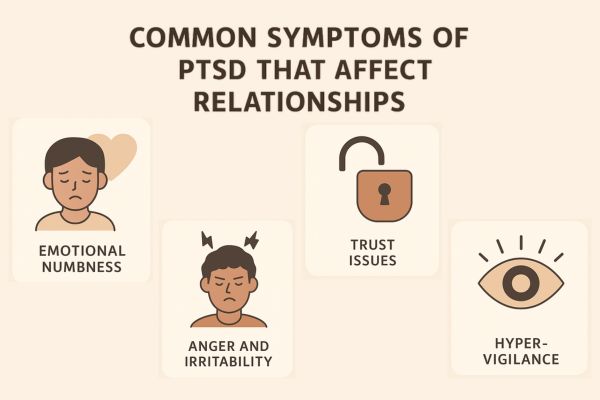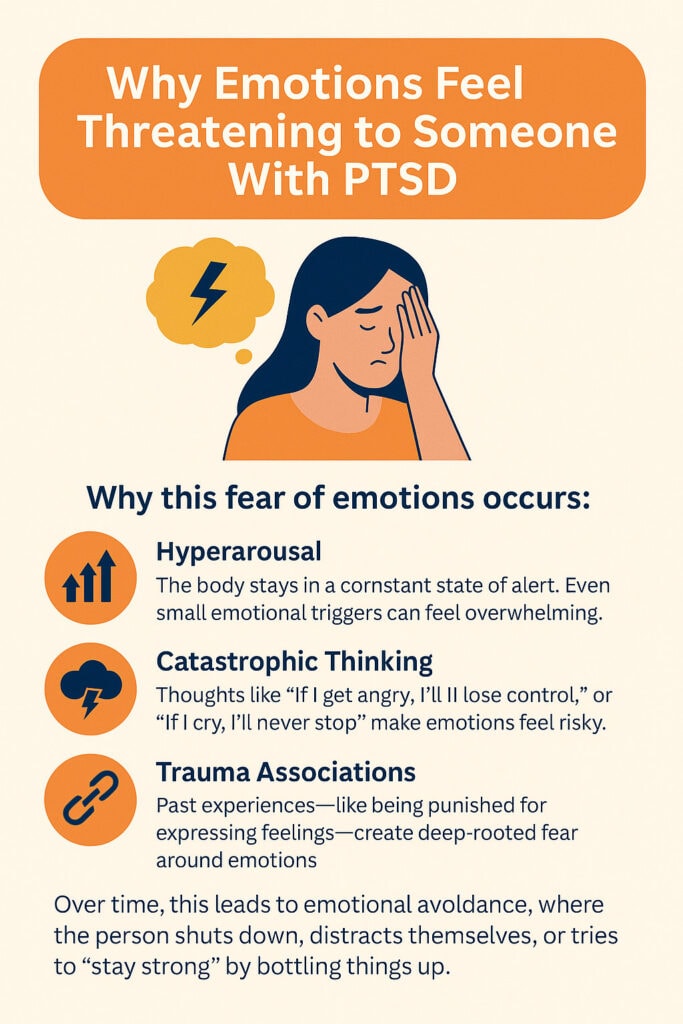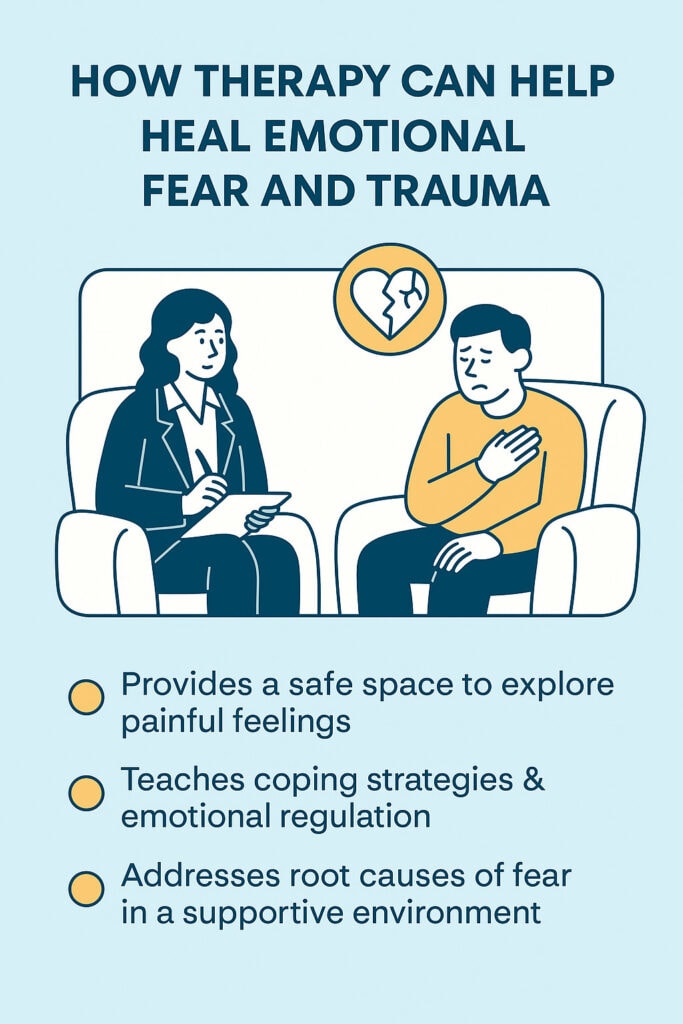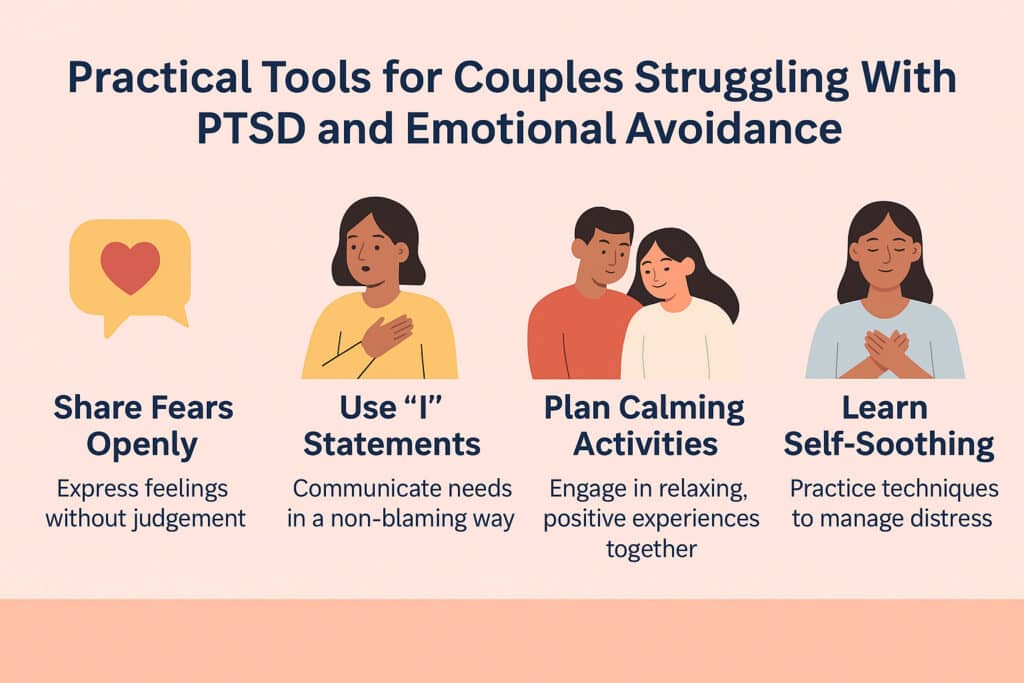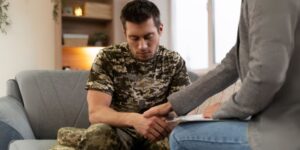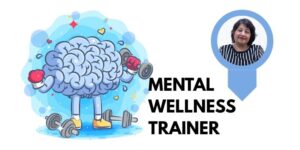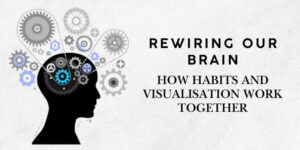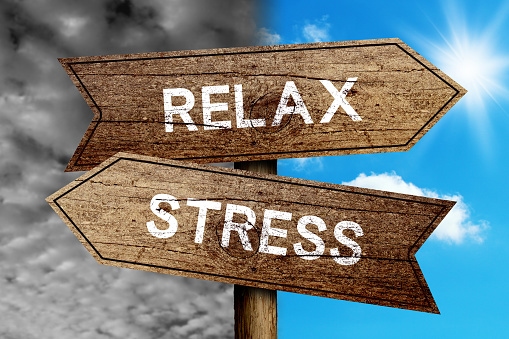“When we fear our own emotions, we build walls instead of bridges—and love cannot survive behind walls.”
Ever found yourself walking on eggshells around your partner’s emotions—or your own? Do you shut down or lash out when things get too emotional? For couples dealing with trauma, especially PTSD, these experiences can become all too familiar.
PTSD doesn’t just impact the person carrying the trauma—it shapes the emotional rhythm of a relationship. What often goes unnoticed is how fear of emotions becomes the silent driver behind frequent conflicts, disconnection, and deep-rooted misunderstandings.
In this blog, we explore how PTSD interferes with emotional expression, fuels unhelpful relationship patterns like demand-withdraw, and how couples can work through it with awareness and support.
Understanding PTSD in Relationships
Post-Traumatic Stress Disorder (PTSD) is often associated with nightmares, flashbacks, or anxiety, but its impact on romantic relationships can be far more subtle and complex.
When someone has PTSD, their nervous system is often on high alert. Their brain is wired to detect danger—even when the threat no longer exists. In a romantic relationship, where emotional vulnerability is key, this can lead to misinterpretations, withdrawal, and frequent arguments.
Common Symptoms of PTSD That Affect Relationships:
- Emotional numbing or withdrawal
- Irritability and sudden anger
- Fear of emotional expression
- Difficulty trusting or feeling safe
- Trouble with intimacy or touch
What might seem like “moodiness” or “coldness” to one partner could actually be a survival strategy developed by the other partner to cope with past trauma.
Why Emotions Feel Threatening to Someone With PTSD
People with PTSD often see emotions—especially intense ones like anger, sadness, or vulnerability—as dangerous. Their inner world treats these feelings as signs that something terrible is about to happen.
Why this fear of emotions occurs:
- Hyperarousal: The body stays in a constant state of alert. Even small emotional triggers can feel overwhelming.
- Catastrophic Thinking: Thoughts like “If I get angry, I’ll lose control,” or “If I cry, I’ll never stop” make emotions feel risky.
- Trauma Associations: Past experiences—like being punished for expressing feelings—create deep-rooted fear around emotions.
Over time, this leads to emotional avoidance, where the person shuts down, distracts themselves, or tries to “stay strong” by bottling things up.
The Demand-Withdraw Pattern: A Painful Push-Pull Dynamic
A very common relationship pattern seen in couples affected by PTSD is the demand-withdraw cycle. This dynamic often emerges when one partner fears emotions and the other desperately seeks emotional connection.
Here’s how it usually plays out:
- One partner becomes emotionally demanding—asking for more talking, closeness, or reassurance.
- The other partner (often with PTSD) feels overwhelmed and withdraws—going silent, walking away, or changing the topic.
- The first partner feels rejected and pushes harder, which increases the other’s need to escape.
This cycle continues, leaving both people frustrated, unseen, and emotionally exhausted.
How PTSD Impacts Communication
Communication is the bridge to connection. But when PTSD is in the picture, it’s like trying to talk across a crumbling rope bridge in a storm.
Common communication challenges:
- Misinterpreting intent: A simple “We need to talk” may be heard as criticism or rejection.
- Freeze response: The person with PTSD might go blank, unable to find words when emotions rise.
- Avoidance of hard conversations: Emotional topics are skirted, leading to unresolved issues.
- Emotional overreactions: Minor conflicts may escalate quickly due to trauma responses.
Instead of creating connection, communication becomes a battlefield—or worse, an empty silence.
How Therapy Can Help Heal Emotional Fear and Trauma
Healing is possible—but it requires addressing both the PTSD symptoms and the underlying fear of emotions. Many people try couples therapy without understanding that standard communication techniques may not work unless trauma is also addressed.
Trauma-informed therapy works by:
- Normalising emotional fear: Helping clients understand that their fear of emotions is a learned protective mechanism, not a weakness.
- Teaching emotional regulation: Clients learn tools to feel emotions without being overwhelmed.
- Rewiring trauma responses: Therapies like EMDR and Brainspotting help the brain process trauma and reduce emotional reactivity.
- Improving relationship dynamics: Couples learn to recognise unhelpful patterns and replace them with supportive behaviours.
Effective Therapeutic Approaches for PTSD in Relationships
If you’re looking into counselling or therapy, here are some approaches that work particularly well when trauma is involved:
-
EMDR (Eye Movement Desensitisation and Reprocessing)
– Helps the brain reprocess traumatic memories
– Reduces emotional triggers that come up in relationships -
Brainspotting Therapy
– Works with the body’s felt sense and brain-body connection
– Helps access deep trauma responses -
Transactional Analysis (TA)
– Supports couples in recognising parent/child/adult roles in communication
– Improves emotional awareness and boundaries -
Gottman Method Couple Therapy
– Offers structured tools to build trust, manage conflict, and enhance emotional intimacy
– Uses research-backed exercises to help couples rebuild connection after trauma -
Couples Therapy with a Trauma Lens
– Focuses on rebuilding trust and safety
– Teaches co-regulation strategies to stay connected during conflict
Practical Tools for Couples Struggling With PTSD and Emotional Avoidance
If you’re navigating a relationship where PTSD plays a role, here are some starting points to bring more awareness and healing into the dynamic:
- Use Emotion Words
Build a vocabulary together: “I feel hurt,” “I feel distant,” or even “I don’t know what I feel, but I’m trying to figure it out.”
- Set Boundaries for Emotional Safety
Agree on signals like “I need a 10-minute pause” or “Can we talk after dinner?” to create structure around emotional conversations.
- Co-Regulate
Do breathing exercises, hold hands, or sit back-to-back when discussing hard topics to soothe each other’s nervous systems.
- Journal Together or Separately
Sometimes writing is easier than talking. Try journaling what’s hard to say, then sharing it when ready.
- Educate Yourselves About Trauma
Read or listen to trauma resources together. Understanding the biology behind reactions reduces shame and blame.
Case Story: Breaking the Emotional Avoidance Cycle
Let’s take a fictional example.
Priya experienced emotional neglect as a child and developed PTSD. Every time her partner Aaron asked her to “open up,” she would shut down. Aaron, feeling hurt and ignored, would push harder. They ended up in shouting matches—or worse, cold silence for days.
When they sought trauma-informed couples counselling, Priya began working on naming her emotions without fear. Aaron learned to listen without pushing. Together, they practiced grounding exercises and slowly rebuilt emotional trust.
Their relationship isn’t perfect—but they no longer feel stuck in the same painful loop.
When to Seek Help
It’s time to consider professional support if:
- You keep having the same arguments with no resolution
- One or both partners feel unsafe expressing emotions
- Emotional or physical intimacy is strained
- Past trauma is interfering with current relationship satisfaction
- You feel more like roommates or opponents than romantic partners
There is no shame in needing help. Healing from trauma is brave—and doing it together is one of the most powerful ways to grow as a couple.
Final Thoughts

PTSD doesn’t just affect the person who lived through the trauma—it echoes through their relationships, especially when emotions feel like enemies. But emotions aren’t the problem—fear of emotions is.
When couples learn to work through emotional avoidance and understand each other’s wounds, they create space for healing, safety, and connection.
You don’t have to keep living in fear of the next argument or misunderstanding. With awareness, the right support, and commitment, relationships strained by PTSD can not only survive—but thrive.
References
- The Role of Emotional Avoidance in PTSD
Tull, M. T., & Roemer, L. (2003). Journal of Anxiety Disorders, 17(4), 447–461.
https://doi.org/10.1016/S0887-6185(02)00232-1 - Emotional Regulation and Relationship Satisfaction in PTSD
Boden, M. T., et al. (2013). Journal of Traumatic Stress, 26(1), 129–134.
https://doi.org/10.1002/jts.21776 - Couples Therapy for PTSD: Cognitive-Behavioral Conjoint Therapy
Monson, C. M., & Fredman, S. J. (2012). Guilford Press.
Offers insight into treating relationship dysfunction rooted in PTSD. - EMDR Institute – Eye Movement Desensitization and Reprocessing
https://www.emdr.com/what-is-emdr/ - Brainspotting Therapy
Developed by David Grand – https://brainspotting.com - Transactional Analysis in Psychotherapy
Berne, E. (1961). A foundational resource for understanding emotional roles in communication. - The Gottman Institute – Conflict and PTSD in Relationships
https://www.gottman.com
Offers tools like co-regulation, soft start-ups, and emotional bids.


